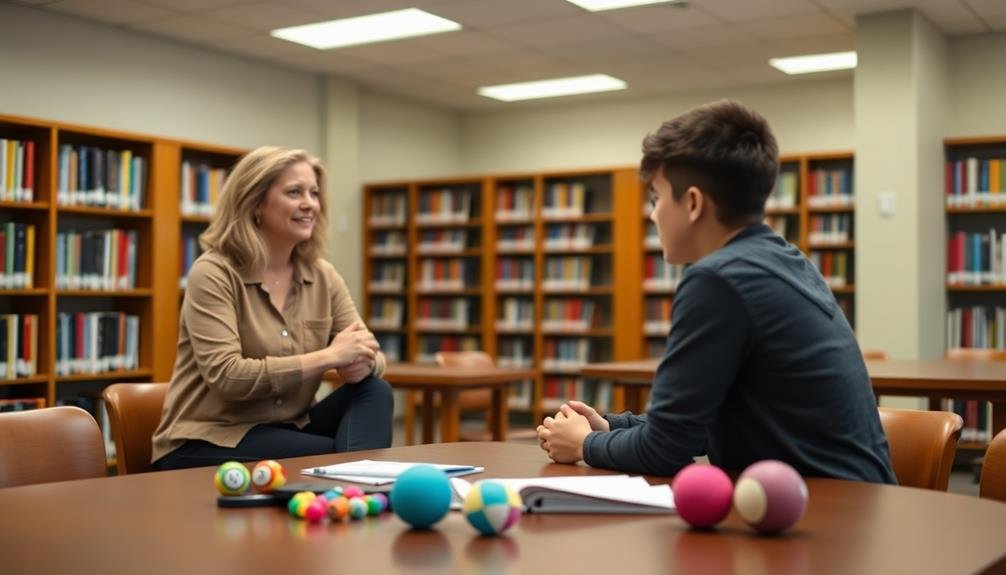If you're looking to volunteer as a tutor but struggle with anxiety, consider these five tips. First, choose online platforms that offer flexible scheduling and clear communication tools. Second, opt for asynchronous methods to reduce real-time pressure. Third, start with small group sessions to ease into a more manageable environment. Fourth, utilize pre-prepared teaching materials to provide structure and reduce improvisation stress. Finally, set clear boundaries and expectations to create a comfortable tutoring experience. By implementing these strategies, you'll find tutoring opportunities that accommodate your needs while making a positive impact. Discover how these approaches can transform your volunteer experience.
Choose Online Tutoring Platforms

Accessibility is key when choosing online tutoring platforms for anxiety-friendly volunteering. Look for platforms that offer flexible scheduling and allow you to set your own hours. This control can help reduce anxiety by letting you volunteer when you feel most comfortable and prepared.
Seek out platforms with clear communication tools, such as built-in messaging systems or video chat options. These features enable you to interact with students in a way that suits your comfort level. Some platforms even allow text-based tutoring, which can be less intimidating for those with social anxiety.
Consider platforms that provide structured lesson plans or resources. Having pre-prepared materials can alleviate the stress of creating content from scratch. Additionally, look for platforms that offer training or orientation sessions to help you feel more confident in your role.
Research platforms that specialize in subjects you're most knowledgeable about. Teaching familiar topics can reduce anxiety by boosting your confidence.
Opt for Asynchronous Communication
For many volunteers with anxiety, real-time interactions can be overwhelming. Opting for asynchronous communication methods can remarkably reduce stress and allow you to contribute effectively as a tutor. Choose platforms that offer message boards, email exchanges, or document sharing features where you can respond to students' questions at your own pace.
Asynchronous tutoring allows you to carefully craft your responses, double-check information, and take breaks when needed. You'll have time to research complex topics and provide thorough explanations without the pressure of immediate replies. This approach also benefits students who prefer to digest information slowly or have busy schedules.
Consider creating pre-recorded video lessons or written tutorials that students can access anytime. This method lets you prepare content when you're feeling most comfortable and confident. You can also use tools like screen recording software to demonstrate problem-solving techniques or explain concepts visually.
Remember to set clear expectations with students about response times and availability. Establish boundaries that work for you, such as checking messages once or twice a day. By embracing asynchronous communication, you can provide valuable tutoring support while managing your anxiety effectively.
Start With Small Group Sessions

Easing into tutoring, small group sessions offer an excellent starting point for volunteers with anxiety. These smaller settings provide a more manageable environment to build your confidence and skills. You'll interact with fewer students at once, reducing the pressure of one-on-one tutoring while still making a meaningful impact.
Start by looking for opportunities to assist in study groups or workshops with 3-5 students. This format allows you to observe group dynamics and contribute gradually. You can begin by helping with specific tasks, like reviewing worksheets or explaining concepts, without feeling responsible for the entire session.
As you become more comfortable, you can take on a more active role in leading discussions or presenting material. Small groups also provide a supportive atmosphere where students can help each other, taking some of the spotlight off you. This collaborative approach can ease your anxiety about being the sole source of information.
Remember to communicate your comfort level with the program coordinator. They can help tailor your involvement to suit your needs and gradually increase your responsibilities as you feel ready.
Utilize Pre-prepared Teaching Materials
Pre-prepared teaching materials can be a lifesaver for anxious tutoring volunteers. They provide structure and reduce the stress of improvising lessons on the spot. You'll find comfort in having a clear plan to follow, allowing you to focus on connecting with your students rather than worrying about content creation.
Look for resources provided by your tutoring organization or reputable educational websites. These materials often include lesson plans, worksheets, and interactive activities. You can adapt them to suit your teaching style and your students' needs. Don't hesitate to use visual aids, such as diagrams or infographics, to enhance your lessons.
Consider creating a toolkit of go-to materials for different subjects and skill levels. This preparation will boost your confidence and help you handle unexpected situations. Here's a sample structure for organizing your toolkit:
| Subject | Beginner | Intermediate | Advanced |
|---|---|---|---|
| Math | Basic arithmetic | Algebra | Calculus |
| English | Vocabulary | Grammar | Essay writing |
| Science | Nature basics | Chemistry | Physics |
| History | Local history | World events | Historiography |
Set Boundaries and Expectations

Setting clear boundaries and expectations is essential for anxiety-friendly tutoring. By establishing these guidelines upfront, you'll create a more comfortable and structured environment for both yourself and your students. Communicate your availability, preferred communication methods, and session durations clearly. This reduces uncertainty and helps manage everyone's expectations.
When setting boundaries and expectations, consider the following:
- Time limits: Specify the start and end times for each session, and stick to them consistently.
- Communication channels: Decide on appropriate ways for students to contact you outside of tutoring hours, such as email or a messaging app.
- Preparation requirements: Outline what you expect from students before each session, like completing specific assignments or reviewing certain materials.
- Progress tracking: Establish a system for monitoring and discussing student progress, ensuring both parties are aware of goals and achievements.
Remember to be flexible within these boundaries, as some students may require additional support or accommodations.
Regularly reassess and adjust your expectations as needed, based on student feedback and your own comfort level. By maintaining clear boundaries and expectations, you'll create a more predictable and anxiety-friendly tutoring experience for everyone involved.
Frequently Asked Questions
How Can I Manage My Own Anxiety While Tutoring Others?
You can manage your anxiety while tutoring by practicing deep breathing, using positive self-talk, and preparing thoroughly. Take breaks when needed, set realistic expectations, and remember that it's okay to not have all the answers immediately.
Are There Specific Subjects Better Suited for Anxiety-Friendly Tutoring?
You'll find subjects like art, music, or creative writing well-suited for anxiety-friendly tutoring. They're often more relaxed and expressive. Languages and math can also work well, as they have clear rules and structures to follow.
What Should I Do if a Student Becomes Anxious During a Session?
If a student becomes anxious during a session, you should remain calm and supportive. Take a break, offer reassurance, and ask if they'd like to try a different approach. Don't pressure them; let them set the pace.
How Can I Build Confidence as a Tutor With Anxiety?
You can build confidence as a tutor by practicing regularly, setting small goals, and celebrating your successes. Focus on your strengths, seek feedback, and remember that it's okay to make mistakes. You're learning and growing too.
Are There Any Anxiety-Specific Training Programs for Volunteer Tutors?
You'll find some anxiety-specific training programs for volunteer tutors. Check with local mental health organizations, schools, or online platforms. They often offer workshops or courses tailored to help tutors manage anxiety while teaching effectively.
In Summary
You've now got the tools to make tutoring more accessible and comfortable for your anxiety. Remember, it's okay to start small and gradually expand your comfort zone. By choosing online platforms, using asynchronous methods, and setting clear boundaries, you're setting yourself up for success. Don't forget to utilize pre-made materials to ease your workload. With these strategies, you'll be able to make a positive impact while managing your anxiety effectively.





Leave a Reply